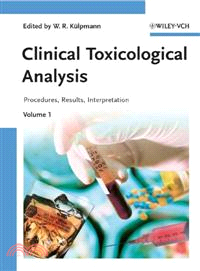Clinical Toxicological Analysis - Methods, Procedures, Interpretation
商品資訊
ISBN13:9783527318902
出版社:John Wiley & Sons Inc
作者:Külpmann
出版日:2009/03/18
裝訂/頁數:精裝/976頁
商品簡介
Neatly divided into two volumes, the first chapters deal with requirements for toxicological analyses, quality assessment, the evaluation of analytical results, forensic aspects, clinical chemistry and therapeutic drug monitoring, while the majority of chapters contain detailed protocols for the analysis of all classes of toxicants.
A handy desktop reference for the practitioner.
作者簡介
目次
Foreword.
Preface.
List of Contributors.
Disclaimer.
Volume 1.
1 Introduction (W.R. Külpmann).
References.
2 Requirements for Toxicological Analyses (F. Degel).
2.1 General Aspects.
2.2 Devices.
2.3 Rooms and Facilities.
2.4 Management and Technical Requirements.
2.5 Chemicals and Reagents.
2.6 Personnel.
References.
3 Materials for Investigation (H.J. Gibitz and F. Pluisch).
3.1 Introduction.
3.2 Judicial Preconditions for Taking and Surrendering Materials for Investigation.
3.3 Containers for Sampling and Storage.
3.4 Kind of Materials.
3.5 Identification of Materials.
3.6 Request Form.
3.7 Transport of Materials.
3.8 Evaluation of Materials.
3.9 Storage of Materials.
3.10 Sampling and Storage of Materials for Forensic Investigation.
References.
4 Methods for Clinical Toxicological Analysis.
4.1 Immunoassays (W.R. Külpmann and D. Hannak).
4.2 Thin-Layer Chromatography (F. Degel).
4.3 High-Performance Liquid Chromatography (H. Käferstein).
4.4 Gas Chromatography (H.H. Maurer).
4.5 Gas Chromatography–Mass Spectrometry (H.H. Maurer).
4.6 Headspace Gas Chromatography (F. Degel).
4.7 Liquid Chromatography–Mass Spectrometry (H.H. Maurer).
4.8 Electrochemical Methods (F. Pragst).
4.9 Capillary Electrophoresis (H. König).
References.
5 Practicability of Clinical Toxicological Analyses (H.J. Gibitz).
5.1 Introduction.
5.2 Aspects of Practicability.
5.3 Personnel Cost.
5.4 Conclusion.
References.
6 Quality Assurance .
6.1 Quantitative Measurements (W.R. Külpmann).
6.2 Qualitative Examinations (L. von Meyer and M. Geldmacher-von Mallinckrodt).
References.
7 Assessment of Analytical Results (W.R. Külpmann, M. Geldmacher-von Mallinckrodt, and J. Hallbach).
7.1 Introduction.
7.2 Technical Level: Analytical Assessment.
7.3 Biological Level: Plausibility Check.
7.4 Nosological Level.
References.
8 The Analytical Toxicological Report (J. Hallbach, M. Geldmacher-von Mallinckrodt, and W.R. Külpmann).
8.1 Introduction.
8.2 The Analytical Toxicological Report.
References.
9 Medical Interpretation (J. Hallbach, N. Felgenhauer, M. Geldmacher-von Mallinckrodt, and H.H. Maurer).
9.1 Overview.
9.2 Differential Diagnosis.
9.3 Poison Information Center.
9.4 Interpretation of Blood, Plasma, or Serum Concentrations.
9.5 Conclusion.
References.
10 Forensic Aspects (W.R. Külpmann).
10.1 Overview.
References.
11 Strategy of Clinical Toxicological Investigations(J. Hallbach, W.R. Külpmann, H.H. Maurer, F. Pragst, and N. Felgenhauer).
11.1 Epidemiology of Poisoning.
11.2 Diagnosis of Poisoning.
11.3 Investigation Request.
11.4 Clinical Toxicological Requirements.
11.5 Documentation.
References.
12 Screening Procedures for ‘‘General Unknown’’ Analysis (F. Pragst, H.H. Maurer, J. Hallbach, W.R. Külpmann, U. Staerk, F. Degel, and M. Lappenberg-Pelzer).
12.1 High-Performance Liquid Chromatography with Photodiode Array Detector (F. Pragst).
12.2 Gas Chromatography (H. H. Maurer).
12.3 Gas Chromatography–Mass Spectrometry (H.H. Maurer).
12.4 Gas Chromatographic Headspace Analysis (F. Degel).
12.5 Color Test: Tetrabromophenolphthalein Ethyl Ester (M. Lappenberg-Pelzer).
References.
13 Nonopioid Analgesics and Antirheumatics (H. König and J. Hallbach).
13.1 Detection of Nonopioid Analgesics and Antirheumatics in Serum and Urine.
13.2 Diclofenac.
13.3 Ibuprofen.
13.4 Metamizole (Dipyrone).
13.5 Paracetamol (Acetaminophen).
13.6 Phenazone (Antipyrine).
13.7 Salicylates.
References.
14 Analgesics: Opiates and Opioids (H. Käferstein).
14.1 Group Assays.
14.2 Buprenorphine (W.R. Külpmann).
14.3 Dextropropoxyphene (H. Käferstein).
14.4 Fentanyl (G. Sticht, H. Käferstein, and L. von Meyer).
14.5 Meperidine (Pethidine) (H. König).
14.6 Methadone (H. Käferstein and A. Schmoldt).
14.7 Morphine and Morphine Derivatives (H. Käferstein and G. Sticht).
14.8 Oxycodone (F. Degel).
14.9 Pentazocine (T. Binscheck).
14.10 Tilidine (T. Binscheck).
14.11 Tramadol (J. Hallbach and H. Käferstein).
References.
15 Antidysrhythmic Agents (H. König and A. Schmoldt).
15.1 Immunoassay.
15.2 High-Performance Liquid Chromatography.
15.3 Gas Chromatography.
15.4 Medical Assessment and Clinical Interpretation.
References.
16 Anticonvulsants (D. Hannak).
16.1 Immunoassay (W.R. Külpmann).
16.2 High-Performance Liquid Chromatography (D. Hannak).
16.3 Gas Chromatography–Mass Spectrometry (J. Hallbach).
16.4 Medical Assessment and Clinical Interpretation (D. Hannak).
References.
17 Anticoagulants (L. von Meyer and M. Geldmacher-von Mallinckrodt).
17.1 Coumarin Derivatives Used in Therapy.
17.2 Rodenticide Coumarin Derivatives.
References.
18 Bronchodilators (W.R. Külpmann).
18.1 Group Assay.
18.2 Caffeine.
18.3 Theophylline.
References.
19 Calcium Channel Blockers (J. Hallbach and A. Schmoldt).
19.1 Nifedipine.
19.2 Verapamil.
References.
20 Cardiac Glycosides (J. Hallbach).
20.1 Digitoxin.
20.2 Digoxin.
References.
21 Hypnotics: Barbiturates (W.R. Külpmann and A. Schmoldt).
21.1 Detection of Barbiturates.
21.2 Methohexital (A. Schmoldt and W.R. Külpmann).
21.3 Phenobarbital (W.R. Külpmann).
21.4 Thiopental (W.R. Külpmann).
References.
22 Hypnotics and Sedatives: Benzodiazepines (L. von Meyer, A. Schmoldt, and W.R. Külpmann).
22.1 Immunoassay.
22.2 High-Performance Liquid Chromatography.
22.3 Gas Chromatography.
22.4 Medical Assessment and Clinical Interpretation.
References.
23 Hypnotics and Sedatives (Except for Barbiturates and Benzodiazepines) (H. König and H. Käferstein).
23.1 Immunoassay.
23.2 High-Performance Liquid Chromatography.
23.3 Gas Chromatography.
23.4 Ion-Selective Electrodes (F. Pragst).
23.5 Photometry (Color Test) (H. J. Gibitz).
23.6 Medical Assessment and Clinical Interpretation.
References.
24 Neuroleptic Drugs and Antidepressants.
24.1 Group Assays.
24.2 High-Performance Liquid Chromatography (H.-J. Birkhahn and D. Lampe).
24.3 High-Performance Liquid Chromatography (Dedicated Systems) (W. Steimer).
24.4 Gas Chromatography (H.-J. Birkhahn and D. Lampe).
24.5 Gas Chromatography–Mass Spectrometry (U. Demme).
24.6 High-Performance Thin-Layer Chromatography (U. Demme).
24.7 High-Performance Liquid Chromatography–Mass Spectrometry (T. Grobosch).
24.8 Medical Assessment and Clinical Interpretation (F. Degel).
References.
Volume 2.
25 β-Receptor Blocking Drugs (L. von Meyer and W.R. Külpmann).
25.1 Immunoassay.
25.2 High-Performance Liquid Chromatography.
25.3 Gas Chromatography.
25.4 Medical Assessment and Clinical Interpretation.
References.
26 Drugs of Abuse (H. Käferstein).
26.1 Amphetamines (G. Sticht and H. Käferstein).
26.2 Cannabinoids (L. von Meyer and H. Käferstein).
26.3 Cocaine (H. Käferstein and G. Sticht).
26.4 γ-Hydroxybutyrate (C. Merckel, V. Auwärter, D. Simmert, and F. Pragst).
26.5 Ketamine (H. König).
26.6 Lysergic Acid Diethylamide (L. von Meyer and W.R. Külpmann).
26.7 Mescaline (W.R. Külpmann).
26.8 Phencyclidine (H. Käferstein and G. Sticht).
26.9 Psilocybin/Psilocin (G. Sticht and H. Käferstein).
27 Solvents and Inhalants.
27.1 Highly Volatile Alcohols and Ketones.
27.2 Aromatics (BTEX) (F. Degel).
27.3 Glycols (F. Degel and H. Desel).
27.4 Volatile Halogenated Hydrocarbons (F. Degel, M. Geldmacher-von Mallinckrodt, and C. Köppel).
27.5 Inhalant Abuse (H.J. Gibitz).
References.
28 Pesticide.
28.1 Introduction (M. Geldmacher-von Mallinckrodt).
28.2 Carbamates (M. Geldmacher-von Mallinckrodt and F. Degel).
28.3 Chlorinated Hydrocarbons (M. Geldmacher-von Mallinckrodt).
28.4 Paraquat (T. Daldrup and C. Köppel).
28.5 Organophosphorus Compounds (M. Geldmacher-von Mallinckrodt).
28.6 Pyrethroids (M. Geldmacher-von Mallinckrodt).
References.
29 Antidiabetics: Proinsulin, Insulin, C-Peptide, and Oral Antidiabetics.
29.1 Insulin, Proinsulin, and C-Peptide (J. Hallbach).
29.2 Oral Antidiabetics: Sulfonylureas (K. Rentsch).
29.3 Medical Assessment and Clinical Interpretation (J. Hallbach and K. Rentsch).
References.
30 Dyshemoglobins (H.J. Gibitz).
30.1 Carboxyhemoglobin.
30.2 Methemoglobin.
30.3 Sulfhemoglobin.
References.
31 Various Drugs and Toxic Agents.
31.1 Chloroquine (M. Geldmacher-von Mallinckrodt and H. Käferstein).
31.2 Nicotine (H. König).
31.3 Strychnine (M. Geldmacher-von Mallinckrodt and H. Käferstein).
31.4 Cyanide.
31.5 Fluoride (F. Pragst).
31.6 Thallium (F. Degel and H. J. Gibitz).
References.
32 Chemical Warfare Agents (M. Koller and L. Szinicz).
32.1 Overview.
32.2 Nerve Agents.
32.3 Vesicants/Blister Agents.
32.4 Lung-Damaging Agents (Choking Agents).
32.5 Blood Agents.
32.6 Psychotomimetic Agents.
32.7 Eye Irritants.
32.8 Nose and Throat Irritants.
References.
33 Biochemical Investigations in Toxicology (W.R. Külpmann).
33.1 Basic Biochemical Investigations.
33.2 Cholinesterase (P. Eyer and F. Worek).
References.
34 Therapeutic Drug Monitoring (W.R. Külpmann).
34.1 Introduction.
34.2 Pharmacokinetics.
34.3 Interpretation.
34.4 Analytical Methods for Drug Monitoring.
References.
35 Poisonous Plants (M. Geldmacher-von Mallinckrodt and L. von Meyer).
35.1 General Aspects.
35.2 Suspected Plant Poisoning: First Diagnostic Steps.
35.3 Aids for Identification of Plants.
35.4 Identification of Plants.
35.5 Toxic Plants' Substances.
35.6 Investigation of Biologic Materials.
References.
36 Poisonous Mushrooms (F. Degel).
36.1 Introduction.
36.2 Classification of Poisonous Mushrooms.
36.3 Frequency of Poisoning.
36.4 Identification of Mushrooms.
36.5 Detection of Mushroom Toxins.
36.6 Medical Assessment and Clinical Interpretation.
References.
37 Venomous and Poisonous Animals (D. Mebs).
37.1 Introduction.
37.2 Venomous and Poisonous Animals.
37.3 Conclusion.
References.
Appendix A Abbreviations.
Appendix B Therapeutic and Toxic Concentrations of Drugs and Xenobiotics in Plasma or Serum.
Appendix C Biological Tolerance Values at the Workplace (BAT Values).
Appendix D Antidotes.
Appendix E Poison Information Centers.
Appendix F List of Narcotic Drugs According to German Law.
Index.
主題書展
更多書展今日66折
您曾經瀏覽過的商品
購物須知
外文書商品之書封,為出版社提供之樣本。實際出貨商品,以出版社所提供之現有版本為主。部份書籍,因出版社供應狀況特殊,匯率將依實際狀況做調整。
無庫存之商品,在您完成訂單程序之後,將以空運的方式為你下單調貨。為了縮短等待的時間,建議您將外文書與其他商品分開下單,以獲得最快的取貨速度,平均調貨時間為1~2個月。
為了保護您的權益,「三民網路書店」提供會員七日商品鑑賞期(收到商品為起始日)。
若要辦理退貨,請在商品鑑賞期內寄回,且商品必須是全新狀態與完整包裝(商品、附件、發票、隨貨贈品等)否則恕不接受退貨。
























